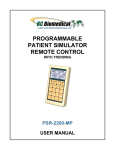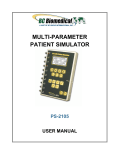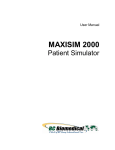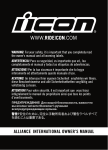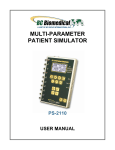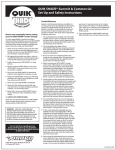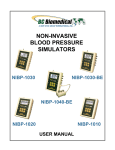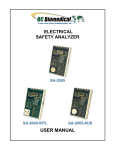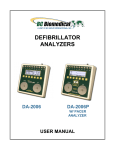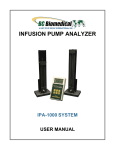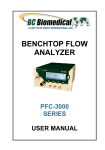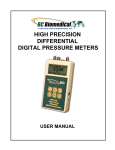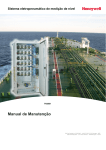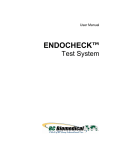Download User Manual - BC Group International Inc.
Transcript
PROGRAMMABLE PATIENT SIMULATOR REMOTE CONTROL WITH TRENDING PSR-2200 USER MANUAL BC BIOMEDICAL PSR-2200 TABLE OF CONTENTS WARNINGS, CAUTIONS, NOTICES .............................................................................. ii DESCRIPTION ............................................................................................................... 1 LAYOUT ......................................................................................................................... 2 KEYS.............................................................................................................................. 3 SCREENS ...................................................................................................................... 5 MESSAGES ................................................................................................................... 7 SETUP ......................................................................................................................... 10 OPERATIONS.............................................................................................................. 11 CONFIGURATION USING A PC .................................................................... 11 CONTROLLING A PATIENT SIMULATOR ..................................................... 18 POWER .......................................................................................................... 20 MANUAL REVISIONS .................................................................................................. 21 LIMITED WARRANTY ................................................................................................. 21 SPECIFICATIONS ....................................................................................................... 22 APPENDIX A – STANDARD CONFIGURATION OUTPUTS ....................................... 23 APPENDIX B – PRE-PROGRAMMED OUTPUTS....................................................... 24 NOTES ......................................................................................................................... 38 This User Manual covers the following units: PSR-2200 i WARNING - USERS The PSR-2200 is for use by skilled technical personnel only. WARNING - USE The PSR-2200 is intended for testing only and should never be used in diagnostics, treatment or any other capacity where it would come in contact with a patient. WARNING - CONNECTIONS All connections to patients must be removed before connecting the DUT to the Patient Simulator and PSR-2200. A serious hazard may occur if the patient is connected when testing with the Patient Simulator & PSR-2200. CAUTION - MODIFICATIONS The PSR-2200 is intended for use within the published specifications. Any application beyond these specifications or any unauthorized user modifications may result in hazards or improper operation. CAUTION - SERVICE The PSR-2200 is intended to be serviced only by authorized service personnel. Troubleshooting and service procedures should only be performed by qualified technical personnel. CAUTION - INSPECTION The PSR-2200 should be inspected before each use for obvious signs of abuse or wear. The PSR-2200 should not be used and should be serviced if any parts are in question. ii CAUTION - CLEANING Do not immerse. The PSR-2200 should be cleaned by wiping gently with a damp, lint-free cloth. A mild detergent can be used if desired. CAUTION - LIQUIDS Do not submerge or spill liquids on the PSR-2200. Do not operate the PSR-2200 if it may have been exposed to fluid. CAUTION - ENVIRONMENT Exposure to environmental conditions outside the specifications can adversely affect the performance of the PSR-2200. Allow the PSR2200 to acclimate to specified conditions for at least 30 minutes before attempting to operate it. NOTICE – ABBREVIATIONS ANSI American National Standards Institute BPM Beats Per Minute C Celsius ° degree(s) DUT Device Under Test ECG Electrocardiogram F Fahrenheit Hz hertz IEC International Electrotechnical Commission Lbs pounds LED Light Emitting Diode mm millimeter(s) mV millivolt(s) NEDA USA V National Electronic Distributors Association United States of America Volt(s) iii NOTICE – DISCLAIMER BC GROUP INTERNATIONAL, INC. WILL NOT BE RESPONSIBLE FOR ANY INJURIES SUSTAINED DUE TO UNAUTHORIZED EQUIPMENT MODIFICATIONS OR APPLICATION OF EQUIPMENT OUTSIDE OF THE PUBLISHED INTENDED USE AND SPECIFICATIONS. NOTICE – DISCLAIMER BC GROUP INTERNATIONAL, INC. RESERVES THE RIGHT TO MAKE CHANGES TO ITS PRODUCTS OR SPECIFICATIONS AT ANY TIME, WITHOUT NOTICE, IN ORDER TO IMPROVE THE DESIGN OR PERFORMANCE AND TO SUPPLY THE BEST POSSIBLE PRODUCT. THE INFORMATION IN THIS MANUAL HAS BEEN CAREFULLY CHECKED AND IS BELIEVED TO BE ACCURATE. HOWEVER, NO RESPONSIBILITY IS ASSUMED FOR INACCURACIES. NOTICE – CONTACT INFORMATION BC BIOMEDICAL BC GROUP INTERNATIONAL, INC. 3081 ELM POINT INDUSTRIAL DRIVE ST. CHARLES, MO 63301 USA 1-800-242-8428 1-314-638-3800 www.bcgroupintl.com [email protected] PSR-2200 User Manual www.bcgroupintl.com 09/12 Copyright © 2012 Made in the USA Rev 07 iv BC BIOMEDICAL PSR-2200 PATIENT SIMULATOR REMOTE CONTROL The Model PSR-2200 is a Microprocessor based remote control for use with the BC Biomedical PS-2200 Series of Patient Simulators. The remote allows the user to configure the patient simulator and provides pre-programmed configurations as well as programmable key functions and key sequences. The following are highlights of some of the main features: 10 FIXED FUNCTION KEYS 18 PROGRAMMABLE FUNCTION KEYS PROGRAMMABLE KEY NAMES UP TO 20 CHARACTERS 10 STEP KEY SEQUENCE PROGRAMMABILITY UP TO 30 HOURS WORTH OF TRENDING CAPABILITY PC INTERFACE FOR SIMPLE CONFIGURATION LARGE GRAPHICS DISPLAY WITH CURSOR SELECTION OF OPTIONS AND SETUP OF PARAMETERS DISPLAY BACKLIGHT WITH ADJUSTABLE TIMER BATTERY LIFE DISPLAY (0 TO 100%) SOFTWARE ADJUSTABLE CONTRAST PROGRAMMABLE AUTO SHUTDOWN TO CONSERVE BATTERY LIFE FLASH UPGRADEABLE FOR EASY FIRMWARE UPDATES IN THE FIELD CUSTOM PROGRAMMABLE FOR LARGE-VOLUME REQUIREMENTS ACCESSORIES: BC20 - 41342 COMMUNICATION CABLE (Mini Din F to DB9 F) (For PC to Remote Programming) OPTIONAL ACCESSORIES: BC20 - 41338 BC20 - 41339 COMMUNICATION CABLE (Mini DIN F to DB9 M) (For remote to MPS-450 or Marq III) COMMUNICATION CABLE ADAPTER (USB to DB9 M) (For use with BC20-41337) 1 LAYOUT This section looks at the layout of the PSR-2200 gives descriptions of the elements that are present. 20 Dual Purpose Light Touch Keys 10 keys for control and configuration. LCD Graphical Display with Backlight: Shows configuration and output setup. 10 Fixed function keys 18 Programmable keys 25’ Coiled Cable For connection to a PC or Patient Simulator 2 KEYS 20 soft touch keys are provided for system operation: – Pressing and holding this key for 3 seconds will turn the unit off. Pressing and releasing this key will toggle NUM LOCK MODE. Num Lock mode is identified by a ‘NUM’ icon in the upper right corner of the screen. – These keys will change the selected item on the screen. The selected item will be highlighted. – In the SELECT MODE, if a parameter has been highlighted, these keys with scroll through the available settings. – This key allows the user to exit the Choices Menu or cancel a selection that has not been entered. – This key selects a changed option. – This key is used to show a list of available choices for the selected setting. – This key toggles the display mode. The available display modes are ECG Output, Blood Pressure Output and Operating Mode. 3 – These are 10 fixed function keys that configure the Patient Simulator for a pre-defined output configuration. NOTE: The default outputs can be adjusted using the PSR2200 keys described above (See the CONTROLLING A PATIENT SIMULATOR Section on page 20 for more details). (See APPENDIX A – STANDARD CONFIGURATION OUTPUTS for a description of the default outputs of these keys.) – These are user-defined keys that are accessed via the NUM LOCK MODE. Num Lock is toggled by pressing the key. NOTE: The PSR-2200 has been pre-configured with a default set of NUM LOCK programmed outputs. Each of these is a programmed sequence (See the TRENDING CAPABILITIES Section on page 16 for more details). (See APPENDIX B – PRE-PROGRAMMED OUTPUTS for a listing of these pre-programmed keys.) – This key displays the user-defined keys by Keyname. Keynames are programmable via the computer interface. 4 SCREENS MAIN SCREENS – There are three main screens: ECG, Blood Pressure and Operating Mode. The available screens can be toggled using . ECG SCREEN – The ECG screen shows the current operating mode of the Patient Simulator as well as the parameters that are available for that mode. Operating modes available to the remote control are ECG, Arrhythmias, Pacemaker, Performance, Fetal/Maternal and Cardiac Output. BLOOD PRESSURE SCREEN – The Blood Pressure screen shows the output settings for the Patient Simulator Invasive Blood Pressure Output. NOTE: Not all patient simulators have four blood pressure channels. Changes made to blood pressure channels that are not present on the patient simulator will not affect the performance or operation of the patient simulator. NOTE: Blood Pressure is not active for all operating modes. 5 OPERATING MODE SCREEN – This screen shows a list of the available Operating Modes. This allows for quickly changing between output modes. The last list item allows for access to the Remote Control Setup screen. ADDITIONAL SCREENS – There are two additional screens: Remote Control Setup and Key List. REMOTE CONTROL SETUP SCREEN – This screen shows the setup for the remote control. It can be accessed as the last item on the Operating Mode Screen. The user can select an Auto-Off period, change the LCD Contrast, as well as view the Battery Life and Firmware Version. (See Setup for more information.) KEY LIST SCREEN – This screen shows the key names for the 18 programmable keys. This gives the user the ability to identify a programmed key by name instead of memorizing key numbers. It can be accessed using the 6 key. MESSAGES Several status messages are available to indicate the present state of the system. The following is a brief description of the available messages: NUM LOCK – This is a small graphic overlay located in the upper right corner of the screen that indicates that the remote is in NUM LOCK MODE and any further key entry will activate the user programmed key configuration. KEY NUMBER– This is a small graphic overlay located in the lower right corner of the screen that indicates which user programmed key function has been loaded. 7 SEQUENCE NUMBER– This is a small graphic overlay located in the lower right corner of the screen that indicates which user programmed key sequence is running. Key Number Sequence Step Time until next step SAVE PROGRESS– This indicator is shown when a key configuration has been successfully sent from the PC. During this process, the key configuration data is being stored to non-volatile memory in the remote control. LOW BATTERY – This message indicates that the batteries are low and should be replaced. 8 COMMUNICATION ERROR – This message indicates that the simulator did not acknowledge a command that was sent to it. If the cables are connected properly, cycle power on the PSR-2200 and the Patient Simulator and try the command again. 9 SETUP The SETUP MODE allows the user to adjust the configuration of the remote. The Setup screen can be entered using the key and then selecting the Remote Control Setup item from the Operating Mode list. The parameters can be changed by using keys to highlight the desired line and options. The Setup screen can be exited using either the to toggle the available or keys. The following is a breakdown of the parameters available in the configuration of the unit and their available options: System Setup Configuration Parameter Auto Off Timer (Min) Backlight Timer Battery Life LCD Contrast Software Description Determines the period of inactivity before the unit is turned OFF. A timer is started when the unit is turned ON and is reset each time a key is pressed. When the timer reaches the value set in this parameter, the power is automatically turned OFF. (NOTE: Setting this parameter to 0 disables the Auto Off timer. When running from line power, the unit does not automatically shut off. Auto Off timer is inactive during a test.) Off – Always off 1-20 sec – The elapsed time after which the backlight will automatically turn off. Always ON – The backlight will be on Displays current life of the battery. At 10%, a warning screen will appear. At 0%, the unit will power down automatically. Sets the contrast of the display screen. Displays current software program. 10 Range 0-30 Minutes Off, 1-20 sec, Always On 0-100% (Read Only) 0-20 (Read Only) OPERATIONS CONFIGURATION USING A PC The remote control can be easily programmed through a serial port on any Windows-based computer. For laptops and computers that do not have a serial port, a USB to serial port adapter can be used. This utility program can also be used to “clone” a specific remote control setup to multiple remotes, once the initial remote control is configured and the key configuration file has been stored to the PC. INSTALLING THE CONFIGURATION UTILITY: To install the windows based configuration utility, simply put the CD into your computer’s drive and follow the on-screen instructions. If the CD does not auto-run, browse to the files contained on the CD and run the SETUP.EXE program. RUNNING THE CONFIGURATION UTILITY: At the end of the installation process, you will be prompted to run the configuration utility. You can start the program at this time, or close the installation program and run the Configuration Utility from an icon that was added to your desktop. NOTE: If the USB to Serial port converter is used, the drivers must be installed before running the utility. 11 MAIN CONFIGURATION SCREEN (AT A GLANCE): This section is utilized to program a key sequence. To end a sequence, set the last step’s time delay to 0. Use this section of the screen to view or change the configuration of the Patient Simulator for the selected Key. Use these buttons to select a key to configure Use this section to select a key as single function or sequence, and to name the key. History of key configuration files. Model Identification of remote. Task Progress Indicator Status message Current Time Today’s Date Com Port being used 12 Key Selection: Use the buttons 1-18 to select a programmable remote key. The selected key will be depressed, as key 1 is shown. When a key is selected, the right half of the screen changes to show the configuration of that key. LIST: This key is used to view/edit the Keynames. Key Information: This box allows the user to select whether a key will perform a single function or run a sequence of functions and to view/edit the Keyname. 13 Key Sequence: When a key is set to run a sequence, this window is used to program each step of the sequence, the delay between each step and the action to be taken at the end of the sequence. Each step can be programmed to a specific Operating Mode. The delay between steps is programmable from 1 to 600 seconds. If any step delay is set to 0 seconds, the sequence will end at that step. At the end of the sequence, the remote can be set to halt at the current setting or to jump to a specific programmable key. Nested sequences can be performed by programming multiple key sequences and having the end of one sequence jump to another. Trending Capabilities: Through the use of Key Sequences, the PSR-2200 is capable of running an endless loop of trended patient physiological data. The 18 separate programmable keys, each of which can be programmed with unique waveform outputs for up to 600 seconds each, can be “daisy-chained” to create a trending pattern with up to 180 unique steps and with a total trend duration of up to 108,000 seconds (30 hours) worth of waveform data. The PSR-2200 comes with a pre-programmed set of sequence data already assigned to specific keys as listed in Appendix B PRE-PROGRAMMED OUTPUTS. 14 Control Buttons: Read Remote: This button is used to read the current settings in the remote. Download To Remote: This button is used to update the remote with the key configurations shown on the screen. Cancel Changes: This button cancels any changes that have been made to the selected key configuration. Once a new key is selected, the changes cannot be canceled. Edit Key Name List: This button is used to show the Keyname list window, which shows a list of all of the Keynames. Load Key Config File: This button is used to open a key configuration file that has been saved on the computer. As files are opened, they are added to the Current Key Config File history for quick future reference. If changes have been made to an open file, you will be prompted to save them before loading a new file. Save Key Config File: This button is used to save the current key settings to a file on the computer. Current Key Config File: This is a listing of the previous config files that have been opened. Selecting a file from the list will cause it to open. If changes have been made to an open file, you will be prompted to save them before loading a new file. 15 Keyname List: The Keyname List is a quick way to view and change all of the Keynames. By selecting a Keyname, the right hand section of the screen will be updated with that key’s configuration. Save: This button is used to accept any changes made to the Keynames and the close the Keyname screen. Cancel: This button is used to close the Keyname screen without saving any Keyname changes that were made. NOTE: Keynames are restricted to 20 characters. 16 Output Configuration: This section shows the Patient Simulator configuration for the selected key. The buttons at the bottom select the Output Mode. The dropdown lists select the setting for each parameter available in the selected output mode. File Menu: This menu allows you to load a key configuration file, save a key configuration file, clear the loaded file list history or exit the program. Edit Menu: The edit menu provides another way to access the Keyname list. 17 CONTROLLING A PATIENT SIMULATOR To control a patient simulator, the remote control is first plugged into the AUX connector of the simulator. PRE-DEFINED FUNCTIONS: A fixed function can be loaded by pressing the desired key. To make adjustments to the output selections, and can be used to select and modify output settings. selected, the When the desired output is key is used to send the configuration to the Patient Simulator. Any changes made on the remote will be immediately made on the Patient Simulator. USER PROGRAMMABLE FUNCTIONS: User programmable functions are accessed through the NUM LOCK MODE. This mode is set by pressing the key. NOTE: The NUM LOCK MODE is identified by the ‘NUM’ icon in the upper right corner of the screen. To select a pre-programmed output, simply press the number of the output while in NUM LOCK MODE. 18 The key can be used to show the list of Keynames that correspond to the user- programmable keys. With the List Mode, the user no longer has to remember which key number corresponds to which Output Mode. The key number can be named and the name is viewed through the Key List Mode. The desired Output Mode and the keys are used to select the key is used to activate that output. When a user-defined key is loaded, a small icon will appear in the lower right corner to identify which key number is loaded. Further modifications can be made to the simulator output by exiting the NUM LOCK MODE and using the and keys to select and modify output parameters. When the desired output is selected, the configuration to the Patient Simulator. key is used to send the Any changes made on the remote will be immediately made on the Patient Simulator. PATIENT SIMULATOR MODE: The PATIENT SIMULATOR OUTPUT MODE (ECG, Arrhythmia, Pacemaker, Performance, Fetal/Maternal, or Cardiac) can be selected easily by pressing the mode selected. key to select the Operating Mode Menu with the current operating The desired Operating Mode and the and keys are used to select the or keys are used to activate the new Output Mode. POWER: To turn the remote control off, hold the key for 3 seconds. 19 SPECIAL CONFIGURATIONS AVAILABLE: The PSR-2200 is a unique and extremely versatile instrument, capable of many different configurations. This capability allows for custom configurations for our large-volume customers who desire a dedicated and functionally unique remote control for their patient simulator fleet. If you have special requirements on a large-scale (typically 50 units or more), please feel free to contact us regarding your needs. POWER The PSR-2200 is designed for use with a standard 9V Alkaline battery. Additionally, the PSR-2200 can also get power from the PS-2200. With the use of a battery eliminator on the PS-2200, the PSR-2200 can operate indefinitely. 20 MANUAL REVISIONS Revision # Program # Revisions Made Rev 01 Rev 02 Rev 03 Rev 04 Rev 05 Rev 06 Rev 07 DT7349CA DT7349CA DT7349CA DT7349CA DT7349CC DT7349CC DT7349CD Preliminary Manual Pre-Programmed Outputs Added Appendices Added Power Information Added Added Backlight Accessories Updated Manual Format Updated LIMITED WARRANTY WARRANTY: BC GROUP INTERNATIONAL, INC. WARRANTS ITS NEW PRODUCTS TO BE FREE FROM DEFECTS IN MATERIALS AND WORKMANSHIP UNDER THE SERVICE FOR WHICH THEY ARE INTENDED. THIS WARRANTY IS EFFECTIVE FOR TWELVE MONTHS FROM THE DATE OF SHIPMENT. EXCLUSIONS: THIS WARRANTY IS IN LIEU OF ANY OTHER WARRANTY EXPRESSED OR IMPLIED, INCLUDING, BUT NOT LIMITED TO ANY IMPLIED WARRANTY OF MERCHANTABILITY OR FITNESS FOR A PARTICULAR PURPOSE. BC GROUP INTERNATIONAL, INC. IS NOT LIABLE FOR ANY INCIDENTAL OR CONSEQUENTIAL DAMAGES. NO PERSON OTHER THAN AN OFFICER IS AUTHORIZED TO GIVE ANY OTHER WARRANTY OR ASSUME ANY LIABILITY. REMEDIES: THE PURCHASER'S SOLE AND EXCLUSIVE REMEDY SHALL BE: (1) THE REPAIR OR REPLACEMENT OF DEFECTIVE PARTS OR PRODUCTS, WITHOUT CHARGE. (2) AT THE OPTION OF BC GROUP INTERNATIONAL, INC., THE REFUND OF THE PURCHASE PRICE. P:\MANUALS\BCGroup\…\PSR-2200\PSR-2200_UM_Rev07.doc 21 SPECIFICATIONS PHYSICAL & ENVIRONMENTAL DISPLAY CONSTRUCTION SIZE LCD Graphical 128 X 64 Pixels, White LED Backlight ENCLOSURE ABS Plastic FACE PLATE Lexan, Back printed 5.98 x 3.27 x 1.28 Inches (151.9 x 83.1 x 32.5 mm) WEIGHT < 1 Lbs (0.45 kg) OPERATING RANGE 15 to 40 °C (59 to 104 °F) STORAGE RANGE -20 to 65 °C (-4° to 149 °F) ELECTRICAL BATTERY 9V Alkaline Battery (1 Required) (NEDA 1604 Alkaline or equivalent) 22 APPENDIX A – STANDARD CONFIGURATION OUTPUTS There are eleven keys on the remote labeled to provide standard outputs. The following tables detail the outputs for each of the keys: Standard Outputs Key Waveform NSR Normal Sinus Rhythm @ 80 BPM Tachy Normal Sinus Rhythm @ 160 BPM Brady Normal Sinus Rhythm @ 30 BPM Ventricular Arrhthmias Asystole Supraventricular Arrhythmias Atrial Flutter Supraventricular Arrhythmias Atrial Finrillation – Coarse Supraventricular Arrhythmias Ventricular Fibrillation - Coarse Ventricular Arrhythmias Ventricular Tachycardia Premature Arrythmias Atrial PAC-Auto Premature Arrythmias PVC 1 – Auto Premature Arrythmias PVC 2 – Auto Asyst A-Flutter A-Fib V-Fib V-Tach PAC PVC1 PVC2 Common Configuration for Standard Outputs Parameter Setting ECG Amplitude 1.0 mV Patient Mode Adult ST Segment 0 mV ECG Artifact None Respiration 30 BrPM Respiration Resistance 1Ω Temperature 37° C 98.6° F BP Channel Settings 0 mmHg 23 APPENDIX B – PRE-PROGRAMMED OUTPUTS The PSR-2200 comes with a pre-programmed set of sequence data already assigned to specific keys as listed below: Performance Waveforms Common Configuration for Performance Outputs Parameter Setting ECG Amplitude 1.0 mV Temperature 30.0° C / 86.0° F BP Channel Settings Not Active KEY 1 – Square/Triangular Waves Sequence Step Waveform Duration 1 Square Wave @ 0.125 Hz 10 seconds 2 Square Wave @ 2.000 Hz 10 seconds 3 Triangle Wave @ 2.000 Hz 10 seconds 4 Triangle Wave @ 2.500 Hz 10 seconds 5 Not Used - 6 Not Used - 7 Not Used - 8 Not Used - 9 Not Used - 10 Not Used - End of Sequence Action Repeat Sequence from Step 1 24 KEY 2 – Sine Waves Sequence Step Waveform Duration 1 Sine Wave @ 0.1 Hz 10 seconds 2 Sine Wave @ 0.5 Hz 10 seconds 3 Sine Wave @ 5.0 Hz 10 seconds 4 Sine Wave @ 10 Hz 10 seconds 5 Sine Wave @ 40 Hz 10 seconds 6 Sine Wave @ 50 Hz 10 seconds 7 Sine Wave @ 60 Hz 10 seconds 8 Sine Wave @ 100 Hz 10 seconds 9 Not Used - 10 Not Used - End of Sequence Action Repeat Sequence from Step 1 KEY 3 – Pulse Wave Sequence Step Waveform Duration 1 Pulse Wave @ 30 BPM 10 seconds 2 Pulse Wave @ 60 BPM 10 seconds 3 Pulse Wave @ 120 BPM 10 seconds 4 Not Used - 5 Not Used - 6 Not Used - 7 Not Used - 8 Not Used - 9 Not Used - 10 Not Used - End of Sequence Action Repeat Sequence from Step 1 25 KEY 4 – R-Wave Sequence Step Waveform Duration 1 R-Wave @ 30 BPM 10 seconds 2 R-Wave @ 60 BPM 10 seconds 3 R-Wave @ 80 BPM 10 seconds 4 R-Wave @ 120 BPM 10 seconds 5 R-Wave @ 200 BPM 10 seconds 6 R-Wave @ 250 BPM 10 seconds 7 Not Used - 8 Not Used - 9 Not Used - 10 Not Used - End of Sequence Action Repeat Sequence from Step 1 26 Blood Pressure Common Configuration for Blood Pressure Outputs Parameter Setting ECG Waveform Normal Sinus Rhythm @ 80 BPM ECG Amplitude 1.0 mV Patient Mode Adult ST Segment 0 mV ECG Artifact None Respiration 30 BrPM Respiration Resistance 1Ω Temperature 37.0° C / 98.6° F KEY 5 – Blood Pressure Sequence Step BP Channels Waveform 1 All Static 0 mmHg 10 seconds 2 All Static 20 mmHg 10 seconds 3 All Static 40 mmHg 10 seconds 4 All Static 60 mmHg 10 seconds 5 All Static 100 mmHg 10 seconds 6 All Static 150 mmHg 10 seconds 7 All Static 200 mmHg 10 seconds 8 All Static 250 mmHg 10 seconds 9 All Static 300 mmHg 10 seconds 10 All Static 400 mmHg 10 seconds End of Sequence Action Duration Repeat Sequence from Step 1 27 Respiration Common Configuration for Respiration Outputs Parameter Setting ECG Waveform Normal Sinus Rhythm @ 80 BPM ECG Amplitude 1.0 mV Patient Mode Adult ST Segment 0 mV ECG Artifact None Respiration Resistance 1Ω Temperature 37.0° C / 98.6° F BP Channel Settings 0 mmHg KEY 6 – Respiration Sequence Step Respiration Rate Duration 1 0 BrPM Apnea 10 seconds 2 15 BrPM 10 seconds 3 20 BrPM 10 seconds 4 30 BrPM 10 seconds 5 40 BrPM 10 seconds 6 60 BrPM 10 seconds 7 80 BrPM 10 seconds 8 100 BrPM 10 seconds 9 120 BrPM 10 seconds 10 Not Used - End of Sequence Action Repeat Sequence from Step 1 28 KEY 7 – Apnea Sequence Step Respiration Rate Duration 1 30 BrPM 30 seconds 2 12 Second Apnea 30 sec step time 3 30 BrPM 30 seconds 4 22 Second Apnea 30 sec step time 5 30 BrPM 30 seconds 6 32 Second Apnea 60 sec step time 7 30 BrPM 10 seconds 8 Apnea 15 seconds 9 Not Used - 10 Not Used - End of Sequence Action Repeat Sequence from Step 1 29 ECG Artifact Common Configuration for Artifact Outputs Parameter Setting ECG Waveform Normal Sinus Rhythm @ 80 BPM ECG Amplitude 1.0 mV Patient Mode Adult ST Segment 0 mV Respiration 30 BrPM Respiration Resistance 1Ω Temperature 37.0° C / 98.6° F BP Channel Settings 0 mmHg KEY 8 – ECG Artifact Sequence Step Artifact Duration 1 None 15 seconds 2 50 Hz Noise 15 seconds 3 60 Hz Noise 15 seconds 4 Muscle 15 seconds 5 Baseline Wander 15 seconds 6 Respiration 15 seconds 7 Not Used - 8 Not Used - 9 Not Used - 10 Not Used - End of Sequence Action Repeat Sequence from Step 1 30 Temperature Common Configuration for Temperature Outputs Parameter Setting Normal Sinus Rhythm @ 80 BPM 1.0 mV Adult 0 mV None 30 BrPM 1Ω 0 mmHg ECG Waveform ECG Amplitude Patient Mode ST Segment ECG Artifact Respiration Respiration Resistance BP Channel Settings Step 1 2 3 4 5 6 7 8 9 10 KEY 9 – Temperature Sequence Temperature Duration 0 Deg C / 32.0 Deg F 15 seconds 24 Deg C / 75.2 Deg F 15 seconds 30 Deg C / 86.0 Deg F 15 seconds 35 Deg C / 95.0 Deg F 15 seconds 37 Deg C / 98.6 Deg F 15 seconds 40 Deg C / 104.0 Deg F 15 seconds 42 Deg C / 107.6 Deg F 15 Seconds Not Used Not Used Not Used End of Sequence Action Repeat Sequence from Step 1 31 Arrhythmias Common Configuration for Arrhythmia Outputs Parameter Setting ECG Amplitude Patient Mode ST Segment ECG Artifact Respiration Respiration Resistance Temperature BP Channel Settings Step 1 2 3 4 5 6 7 8 9 10 KEY 10 – Premature Sequence Premature Arrhythmia Waveform Duration Atrial PAC – Auto 60 seconds Nodal PNC – Auto 60 seconds PVC 1 – Auto 60 seconds PVC 1 Early – Auto 60 seconds PVC 1 R on R – Auto 60 seconds PVC 2 – Auto 60 seconds PVC 2 Early – Auto 60 seconds PVC R on T – Auto 60 seconds Multifocal PVC – Auto 60 seconds Not Used End of Sequence Action Repeat Sequence from Step 1 Step 1 2 3 4 5 6 7 8 9 10 1.0 mV Adult 0 mV None 30 BrPM 1Ω 37.0 Deg C / 98.6 Deg F 0 mmHg KEY 11 – Supraventricular Sequence Supervent Arrhythmia Waveform Duration Atrial Fibrillation – Course 60 seconds Atrial Fibrillation – Fine 60 seconds Atrial Flutter 60 seconds Atrial Tachycardia 60 seconds Paroxysmal Atrial Tachycardia 60 seconds Supraventricular Tachycardia 60 seconds Sinus Arrhythmia 60 seconds Missed Beat – Auto 60 seconds 60 seconds Missed Beat – Manual Nodal Rhythm 60 seconds End of Sequence Action Repeat Sequence from Step 1 32 Step 1 2 3 4 5 6 7 8 9 10 Pair of PVCs – Auto 60 seconds Run of 5 PVCs – Auto 60 seconds Run of 11 PVCs – Auto 60 seconds 6 PVCs per Minute 60 seconds 12 PVCs per Minute 60 seconds 24 PVCs per Minute 60 seconds Frequent Multifocal PVCs 60 seconds Bigeminy 60 seconds Trigeminy 60 seconds Ventricular Tachycardia 60 seconds End of Sequence Action Repeat Sequence from Step 1 Step 1 2 3 4 5 6 7 8 9 10 KEY 13 – Conduction Sequence Conduction Arrhythmia Waveform Duration 1st Degree Heart Block 60 seconds 2nd Degree Heart Block 60 seconds rd 3 Degree Heart Block 60 seconds Right Bundle Branch Block 60 seconds Left Bundle Branch Block 60 seconds Not Used Not Used Not Used Not Used Not Used End of Sequence Action Repeat Sequence from Step 1 Step 1 2 3 4 5 6 7 8 9 10 KEY 12 – Ventricular Sequence Ventricular Arrhythmia Waveform Duration KEY 14 – Pacemaker Sequence Pacemaker Waveform Duration Atrial @ 80 BPM 60 seconds Asynchronous @ 75 BPM 60 seconds Non-Capture 60 seconds Non- Function 60 seconds Demand – Occasional 60 seconds Demand – Frequent 60 seconds AV Sequential 60 seconds Not Used Not Used Not Used End of Sequence Action Repeat Sequence from Step 1 33 Fetal / Maternal Common Configuration for Fetal / Maternal Outputs Parameter Setting Maternal ECG Fetal ECG Trigger Mode Step 1 2 3 4 5 6 7 8 9 10 80 BPM 120 BPM 2 Minutes KEY 15 – Fetal / Maternal Sequence IUP Simulation Duration Uniform Deceleration 360 seconds Early Deceleration 360 seconds Late Deceleration 360 seconds Uniform Acceleration 360 seconds Not Used Not Used Not Used Not Used Not Used Not Used End of Sequence Action Repeat Sequence from Step 1 Sick Patient Common Configuration for Sick Patient Outputs Parameter Setting ECG Amplitude Patient Mode Respiration Resistance 1.0 mV Adult 1Ω 34 Step 1 2 3 4 5 6 7 8 9 10 KEY 16 – Sick Patient 1 Sequence IUP Simulation Duration Heart Rate ST Elevation Artifact Respiration Temperature BP Channel 1 Heart Rate ST Elevation Artifact Respiration Temperature BP Channel 1 Heart Rate ST Elevation Artifact Respiration Temperature BP Channel 1 Heart Rate ST Elevation Artifact Respiration Temperature BP Channel 1 Heart Rate ST Elevation Artifact Respiration Temperature BP Channel 1 Heart Rate ST Elevation Artifact Respiration Temperature BP Channel 1 Heart Rate ST Elevation Artifact Respiration Temperature BP Channel 1 Heart Rate ST Elevation Artifact Respiration Temperature BP Channel 1 90 BPM 0.1 mV None 40 BrPM 35 Deg C/95 Deg F 120/80 100 BPM 0.0 mV Respiration 40 BrPM 40 Deg C/104 Deg F 120/80 w/5 mm artifact 120 BPM 0.5 mV Baseline Wander 60 BrPM 40 Deg C/104 Deg F 120/80 w/10 mm artifact 140 BPM 0.4 mV Muscle 60 BrPM 42 Deg C/104 Deg F 120/80 w/10 mm artifact 180 BPM 0.8 mV Baseline Wander 80 BrPM 40 Deg C/104 Deg F 120/80 w/16 mm artifact 140 BPM 0.4 mV None 60 BrPM 40 Deg C/104 Deg F 120/80 w/10 mm artifact 100 BPM 0.1 mV Baseline Wander 40 BrPM 35 Deg C/95 Deg F 120/80 90 BPM 0.1 mV None 40 BrPM 35 Deg C/95 Deg F 120/80 Not Used Not Used End of Sequence Action 35 60 seconds 15 seconds 30 seconds 10 seconds 15 seconds 15 seconds 15 seconds 15 seconds - Repeat Sequence from Step 1 NSR Rate Common Configuration for NSR Rate Outputs Parameter Setting ECG Amplitude Patient Mode ST Segment ECG Artifact Respiration Respiration Resistance Temperature BP Channel Settings Step 1 2 3 4 5 6 7 8 9 10 1.0 mV Adult 0 mV None 30 BrPM 1Ω 37.0 Deg C / 98.6 Deg F 120/80 KEY 17 – NSR Rate Ramp Sequence ECG Respiration Duration 20 BPM 40 BPM 45 BPM 60 BPM 80 BPM 90 BPM 100 BPM 120 BPM 140 BPM 180 BPM End of Sequence Action 15 BrPM 15 seconds 20 BrPM 15 seconds 40 BrPM 15 seconds 60 BrPM 15 seconds 80 BrPM 15 seconds 80 BrPM 15 seconds 100 BrPM 15 Seconds 120 BrPM 15 Seconds 120 BrPM 15 Seconds 120 BrPM 15 Seconds Repeat Sequence from Step 1 36 Ventricular Fibrillation Common Configuration for V-Fib Outputs Parameter Setting ECG Amplitude Patient Mode ST Segment ECG Artifact Respiration Respiration Resistance Temperature BP Channel Settings Step 1 2 3 4 5 6 7 8 9 10 1.0 mV Adult 0 mV None 30 BrPM 1Ω 37.0 Deg C / 98.6 Deg F 0 mmHg KEY 18 – V-Fib Sequence Waveform Duration NSR @ 80 BPM 30 seconds Run of 5 PVCs 30 seconds NSR @ 80 BPM 30 seconds Run of 11 PVCs 30 seconds Ventricular Tachycardia 15 seconds Ventricular Fibrillation – Course 10 seconds Ventricular Fibrillation – Fine 10 seconds Asystole 10 seconds Not Used Not Used End of Sequence Action Repeat Sequence from Step 1 37 NOTES 38 NOTES 39 NOTES 40 BC GROUP INTERNATIONAL, INC. 3081 ELM POINT INDUSTRIAL DRIVE ST. CHARLES, MO 63301 USA 1-800-242-8428 1-314-638-3800 www.bcgroupintl.com [email protected] PSR-2200 User Manual 09/12 – Rev 07 Copyright © 2012 Made in the USA
















































